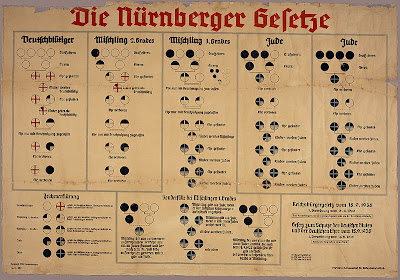
The Nuremberg Laws of 1935 were anti-Semitic laws in Nazi Germany which were introduced at the annual Nazi Party rally in Nuremberg. The laws classified people as German if four of their grandparents were of "German or kindred blood", while people were classified as Jews if they descended from three or four Jewish grandparents. A person with one or two Jewish grandparents was a Mischling, a crossbreed, of "mixed blood". The Nuremberg Laws deprived Jews of citizenship and prohibited marriage between Jews and other Germans.
During the spring and summer of 1933, the disenchantment with how the Third Reich had developed in practice as opposed to what had been promised had led to many in the Nazi Party, especially the (Old Fighters (those who joined the Party before 1930, and who tended to be the most ardent anti-Semites in the Party), and the SA into lashing out against Germany's Jewish minority as a way of expressing their frustrations against a group that the authorities would not generally protect. A Gestapo report from the spring of 1935 stated that the rank and file of the Nazi Party would "set in motion by us from below" a solution to the "Jewish problem", "that the government would then have to follow". As a result, Nazi Party activists and SA members started a major wave of assaults, vandalism and boycotts against German Jews. A conference of ministers was held on August 20, 1935 to discuss the negative economic effects of Party actions against Jews. Adolf Hitler, the Party representative at the conference, argued that such effects would cease, once the government decided on a firm policy against the Jews.
From Hitler's perspective, it was imperative to bring in harsh new anti-Semitic laws as a consolation prize for those Party members who were disappointed with Hitler's halt order (to stop vandalism against the Jews) of August 8, especially because Hitler had only reluctantly given the halt order for pragmatic reasons, and his sympathies were with the Party radicals.
On the evening of September 15, two measures were announced to the Reichstag at the annual Party Rally in Nuremberg, becoming known as the Nuremberg Laws.
The first law, The Law for the Protection of German Blood and German Honour, prohibited marriages and extramarital intercourse between Jews and Germans and also the employment of German females under forty-five in Jewish households.
The second law, The Reich Citizenship Law, stripped persons not considered of German blood of their German citizenship.
The measures were unanimously adopted by the Reichstag. In twelve years of Nazi rule, the Reichstag only passed four laws: the Nuremberg laws were two of them.
The Nuremberg Laws by their general nature formalized the unofficial and particular measures taken against Jews up to 1935.
As a result, Jews were barred from employment as lawyers, doctors or journalists, prohibited from using state hospitals and could not be educated by the state past the age of 14. Public parks, libraries and beaches were closed to Jews. War memorials were to have Jewish names expunged. Even the lottery could not award winnings to Jews.
From September 1941 all Jewish people living within the Nazi empire, including Germany, were required to wear a yellow badge, which had been required in Poland beginning in 1939.
The claim has been made that the Nuremberg Laws were inspired partly by the anti-miscegenation laws of the United States of America, however the principal inspiration for Nazi racial thinking was the British-German author, Houston Stewart Chamberlain who was inspired in turn by the eugenics theories of Sir Francis Galton, which were then widely practised in the British Empire.
Source: Wikipedia (All text is available under the terms of the GNU Free Documentation License)
